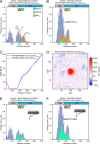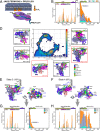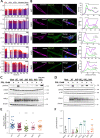The prolactin receptor scaffolds Janus kinase 2 via co-structure formation with phosphoinositide-4,5-bisphosphate
- PMID: 37232489
- PMCID: PMC10260020
- DOI: 10.7554/eLife.84645
The prolactin receptor scaffolds Janus kinase 2 via co-structure formation with phosphoinositide-4,5-bisphosphate
Abstract
Class 1 cytokine receptors transmit signals through the membrane by a single transmembrane helix to an intrinsically disordered cytoplasmic domain that lacks kinase activity. While specific binding to phosphoinositides has been reported for the prolactin receptor (PRLR), the role of lipids in PRLR signaling is unclear. Using an integrative approach combining nuclear magnetic resonance spectroscopy, cellular signaling experiments, computational modeling, and simulation, we demonstrate co-structure formation of the disordered intracellular domain of the human PRLR, the membrane constituent phosphoinositide-4,5-bisphosphate (PI(4,5)P2) and the FERM-SH2 domain of the Janus kinase 2 (JAK2). We find that the complex leads to accumulation of PI(4,5)P2 at the transmembrane helix interface and that the mutation of residues identified to interact specifically with PI(4,5)P2 negatively affects PRLR-mediated activation of signal transducer and activator of transcription 5 (STAT5). Facilitated by co-structure formation, the membrane-proximal disordered region arranges into an extended structure. We suggest that the co-structure formed between PRLR, JAK2, and PI(4,5)P2 locks the juxtamembrane disordered domain of the PRLR in an extended structure, enabling signal relay from the extracellular to the intracellular domain upon ligand binding. We find that the co-structure exists in different states which we speculate could be relevant for turning signaling on and off. Similar co-structures may be relevant for other non-receptor tyrosine kinases and their receptors.
Keywords: IDP; JAK2; NMR; human; integrative structural biology; molecular biophysics; simulation; single pass receptor; structural biology.
© 2023, Araya-Secchi et al.
Conflict of interest statement
RA, KB, PS, AP, GH, KL, SP, LA, BK No competing interests declared
Figures















Update of
- doi: 10.1101/2022.11.23.517650
Similar articles
-
SOCS-1, -2, -3: selective targets and functions downstream of the prolactin receptor.Mol Cell Endocrinol. 1999 Dec 20;158(1-2):45-54. doi: 10.1016/s0303-7207(99)00180-x. Mol Cell Endocrinol. 1999. PMID: 10630404
-
A non-catalytic function of the Src family tyrosine kinases controls prolactin-induced Jak2 signaling.Cell Signal. 2010 Mar;22(3):415-26. doi: 10.1016/j.cellsig.2009.10.013. Cell Signal. 2010. PMID: 19892015
-
Growth hormone signaling in human T47D breast cancer cells: potential role for a growth hormone receptor-prolactin receptor complex.Mol Endocrinol. 2011 Apr;25(4):597-610. doi: 10.1210/me.2010-0255. Epub 2011 Feb 10. Mol Endocrinol. 2011. PMID: 21310852 Free PMC article.
-
Prolactin mediated intracellular signaling in mammary epithelial cells.J Mammary Gland Biol Neoplasia. 1997 Jan;2(1):19-27. doi: 10.1023/a:1026317428542. J Mammary Gland Biol Neoplasia. 1997. PMID: 10887516 Review.
-
Prolactin receptor gene transcriptional control, regulatory modalities relevant to breast cancer resistance and invasiveness.Front Endocrinol (Lausanne). 2022 Sep 15;13:949396. doi: 10.3389/fendo.2022.949396. eCollection 2022. Front Endocrinol (Lausanne). 2022. PMID: 36187116 Free PMC article. Review.
Cited by
-
Current Insights in Prolactin Signaling and Ovulatory Function.Int J Mol Sci. 2024 Feb 6;25(4):1976. doi: 10.3390/ijms25041976. Int J Mol Sci. 2024. PMID: 38396659 Free PMC article. Review.
-
NEK kinases in cell cycle regulation, DNA damage response, and cancer progression.Tissue Cell. 2025 Jun;94:102811. doi: 10.1016/j.tice.2025.102811. Epub 2025 Feb 28. Tissue Cell. 2025. PMID: 40037068 Review.
-
Charge-based immunoreceptor signalling in health and disease.Nat Rev Immunol. 2025 Apr;25(4):298-311. doi: 10.1038/s41577-024-01105-6. Epub 2024 Nov 11. Nat Rev Immunol. 2025. PMID: 39528837 Review.
-
Structural Modeling of Cytokine-Receptor-JAK2 Signaling Complexes Using AlphaFold Multimer.J Chem Inf Model. 2023 Sep 25;63(18):5874-5895. doi: 10.1021/acs.jcim.3c00926. Epub 2023 Sep 11. J Chem Inf Model. 2023. PMID: 37694948 Free PMC article.
-
Structural modeling of cytokine-receptor-JAK2 signaling complexes using AlphaFold Multimer.bioRxiv [Preprint]. 2023 Jun 14:2023.06.14.544971. doi: 10.1101/2023.06.14.544971. bioRxiv. 2023. Update in: J Chem Inf Model. 2023 Sep 25;63(18):5874-5895. doi: 10.1021/acs.jcim.3c00926. PMID: 37398331 Free PMC article. Updated. Preprint.
References
-
- Abraham MJ, Murtola T, Schulz R, Páll S, Smith JC, Hess B, Lindahl E. GROMACS: high performance molecular Simulations through multi-level parallelism from laptops to supercomputers. SoftwareX. 2015;1–2:19–25. doi: 10.1016/j.softx.2015.06.001. - DOI
-
- Aksamitiene E, Achanta S, Kolch W, Kholodenko BN, Hoek JB, Kiyatkin A. Prolactin-stimulated activation of Erk1 / 2 mitogen-activated protein Kinases is controlled by Pi3-kinase / RAC / PAK signaling pathway in breast cancer cells. Cellular Signalling. 2011;23:1794–1805. doi: 10.1016/j.cellsig.2011.06.014. - DOI - PMC - PubMed
Publication types
MeSH terms
Substances
LinkOut - more resources
Full Text Sources
Molecular Biology Databases
Research Materials
Miscellaneous

